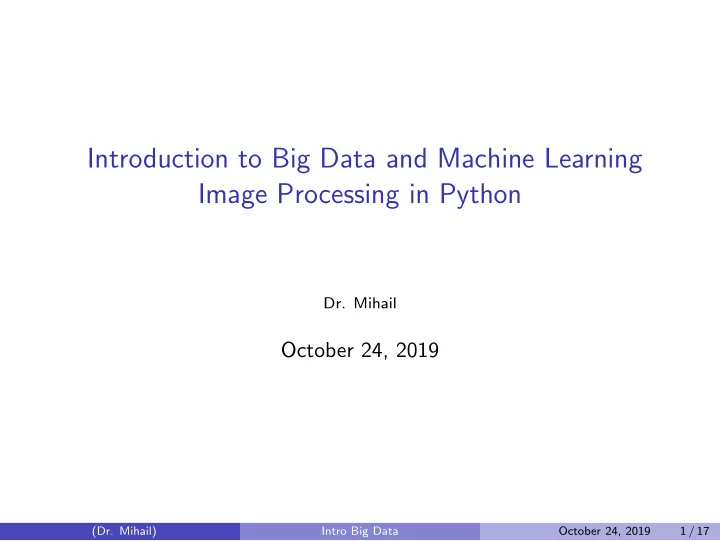

Introduction to Big Data and Machine Learning Image Processing in Python Dr. Mihail October 24, 2019 (Dr. Mihail) Intro Big Data October 24, 2019 1 / 17
Image processing Images are 2D numerical arrays Medical imagery such as CTs or MRIs are 3D tensors, or even 3D+time such as fMRI In Python, while imagery can be stored with almost any container data type, we will use numpy.array We will use numpy for basic array manipulation We will use skimage.io for loading/saving images We will use scipy.ndimage for image processing routines from scipy import ndimage (Dr. Mihail) Intro Big Data October 24, 2019 2 / 17
Image processing Tasks Input/Output, displaying images Basic manipulations: cropping, flipping, rotating Image filtering: denoising, sharpening Image segmentation: labeling pixels corresponding to different objects Classification Feature extraction Registration etc. (Dr. Mihail) Intro Big Data October 24, 2019 3 / 17
Opening an image Code from skimage.io import imread import numpy as np import matplotlib.pyplot as plt im = imread( ' https://mypages.valdosta.edu/rpmihail/teaching/F19/ CS4731/futuristic.jpg ' ) print( ' Data type: ' , im.dtype) print( ' Shape: ' , im.shape) (Dr. Mihail) Intro Big Data October 24, 2019 4 / 17
Displaying an image Red, Green and Blue Channels fig, ax = plt.subplots(1, 4, figsize=(20, 20)) ax[0].imshow(im), ax[0].axis( ' off ' ), ax[0].set_title( ' Original ' ) ax[1].imshow(im[:, :, 0], cmap=plt.cm.gray), ax[1].axis( ' off ' ), ax[1].set_title( ' Red ' ) ax[2].imshow(im[:, :, 1], cmap=plt.cm.gray), ax[2].axis( ' off ' ), ax[2].set_title( ' Green ' ) ax[3].imshow(im[:, :, 2], cmap=plt.cm.gray), ax[3].axis( ' off ' ), ax[3].set_title( ' Blue ' ) (Dr. Mihail) Intro Big Data October 24, 2019 5 / 17
Basic manipulations Masking from scipy import misc im = misc.face(gray=True) lx, ly = face.shape X, Y = np.ogrid[0:lx, 0:ly] mask = np.sqrt((X - lx / 2) ** 2 + (Y - ly / 2) ** 2) > 300 im[mask] = 0 plt.imshow(im) (Dr. Mihail) Intro Big Data October 24, 2019 6 / 17
Statistical information Stats im = misc.face(gray=True) print(im.mean()) print(im.max(), im.min()) (Dr. Mihail) Intro Big Data October 24, 2019 7 / 17
Basic manipulations Transformations from scipy import ndimage im = misc.face(gray=True) lx, ly = im.shape # Cropping crop_im = im[lx // 4: - lx // 4, ly // 4: - ly // 4] # up <-> down flip flip_ud_im = np.flipud(im) # rotation rotate_im = ndimage.rotate(im, 45) rotate_im_noreshape = ndimage.rotate(im, 45, reshape=False) plt.figure() plt.imshow(rotate_im) plt.figure() plt.imshow(rotate_im_noreshape) (Dr. Mihail) Intro Big Data October 24, 2019 8 / 17
Basic manipulations Image filtering Local filters: replace the value of pixels by a function of the values of neighboring pixels. Neighbourhood: square (choose size), disk, or more complicated structuring element. Kernels (Dr. Mihail) Intro Big Data October 24, 2019 9 / 17
Basic manipulations Filters from scipy import misc im = misc.face(gray=True) blurred = ndimage.gaussian_filter(im, sigma=3) very_blurred = ndimage.gaussian_filter(im, sigma=5) local_mean = ndimage.uniform_filter(im, size=11) fig, ax = plt.subplots(1, 3, figsize=(20, 20)) ax[0].imshow(blurred), ax[0].axis( ' off ' ), ax[0].set_title( ' Blurred ' ) ax[1].imshow(very_blurred), ax[1].axis( ' off ' ), ax[1].set_title( ' Very blurred ' ) ax[2].imshow(local_mean, cmap=plt.cm.gray), ax[2].axis( ' off ' ), ax [2].set_title( ' Uniform ' ) (Dr. Mihail) Intro Big Data October 24, 2019 10 / 17
Basic manipulations Sharpening from scipy import misc im = misc.face(gray=True).astype(float) blurred_f = ndimage.gaussian_filter(im, 3) filter_blurred_im = ndimage.gaussian_filter(blurred_f, 1) alpha = 30 #increase the weight of edges by adding an approximation of the Laplacian: sharpened = blurred_f + alpha * (blurred_f - filter_blurred_im) fig, ax = plt.subplots(1, 2, figsize=(20, 20)) ax[0].imshow(blurred_f), ax[0].axis( ' off ' ), ax[0].set_title( ' Blurred ' ) ax[1].imshow(sharpened), ax[1].axis( ' off ' ), ax[1].set_title( ' Sharpened ' ) (Dr. Mihail) Intro Big Data October 24, 2019 11 / 17
Basic manipulations Edge detection im = np.zeros((256, 256)) im[64:-64, 64:-64] = 1 im = ndimage.rotate(im, 15, mode= ' constant ' ) im = ndimage.gaussian_filter(im, 8) sx = ndimage.sobel(im, axis=0, mode= ' constant ' ) sy = ndimage.sobel(im, axis=1, mode= ' constant ' ) sob = np.hypot(sx, sy) plt.figure(figsize=(16, 5)), plt.subplot(141) plt.imshow(im, cmap=plt.cm.gray), plt.axis( ' off ' ) plt.title( ' square ' , fontsize=20), plt.subplot(142) plt.imshow(sx), plt.axis( ' off ' ) plt.title( ' Sobel (x direction) ' , fontsize=20) plt.subplot(143), plt.imshow(sob), plt.axis( ' off ' ) plt.subplots_adjust(wspace=0.02, hspace=0.02, top=1, bottom=0, left=0, right=0.9) plt.show() (Dr. Mihail) Intro Big Data October 24, 2019 12 / 17
Recommend
More recommend